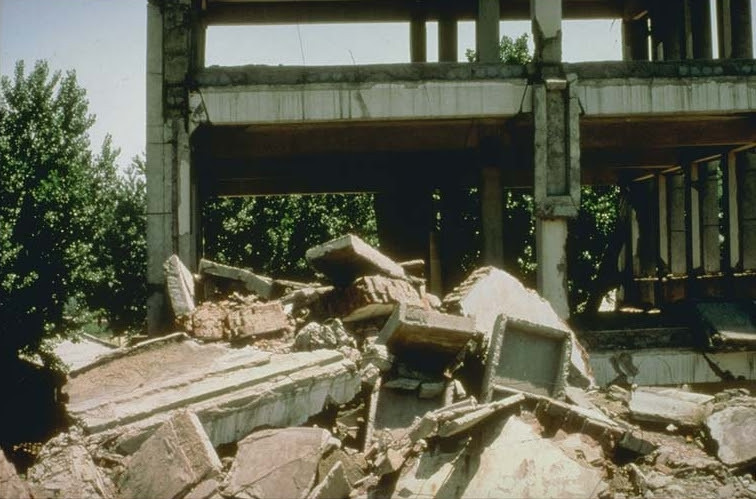segunda-feira, julho 28, 2025
O Grande Sismo de Tangshan foi há 49 anos....
Postado por
Fernando Martins
às
00:49
0
bocas
![]()
Marcadores: China, Grande Sismo de Tangshan, previsão de sismos, revolução cultural, sismologia
domingo, julho 28, 2024
O Grande Sismo de Tangshan foi há 48 anos....
Postado por
Fernando Martins
às
00:48
0
bocas
![]()
Marcadores: China, Grande Sismo de Tangshan, previsão de sismos, revolução cultural, sismologia
sexta-feira, julho 28, 2023
O Grande Sismo de Tangshan foi há 47 anos....
Postado por
Fernando Martins
às
00:47
0
bocas
![]()
Marcadores: China, Grande Sismo de Tangshan, previsão de sismos, revolução cultural, sismologia
quinta-feira, julho 28, 2022
O Grande Sismo de Tangshan foi há 46 anos....
Postado por
Fernando Martins
às
00:46
0
bocas
![]()
Marcadores: China, Grande Sismo de Tangshan, previsão de sismos, revolução cultural, sismologia
quarta-feira, julho 28, 2021
O inacreditável Grande Sismo de Tangshan foi há 45 anos....
Postado por
Fernando Martins
às
00:45
0
bocas
![]()
Marcadores: China, Grande Sismo de Tangshan, previsão de sismos, revolução cultural, sismologia
terça-feira, julho 28, 2020
O Grande Sismo de Tangshan foi há 44 anos
Postado por
Fernando Martins
às
04:40
0
bocas
![]()
Marcadores: China, Grande Sismo de Tangshan, previsão de sismos, revolução cultural, sismologia
domingo, julho 28, 2019
O Sismo de Tangshan foi há 43 anos
Postado por
Fernando Martins
às
04:30
0
bocas
![]()
Marcadores: China, Grande Sismo de Tangshan, previsão de sismos, revolução cultural, sismologia
quinta-feira, julho 28, 2016
Há 40 anos houve um espantoso sismo em Tangshan
Postado por
Fernando Martins
às
00:40
0
bocas
![]()
Marcadores: China, Grande Sismo de Tangshan, previsão de sismos, sismo, Tangshan
segunda-feira, julho 28, 2014
Há 38 anos a China provou que ainda não era possível prever sismos
Postado por
Fernando Martins
às
23:38
0
bocas
![]()
Marcadores: China, Grande Sismo de Tangshan, previsão de sismos, revolução cultural, sismologia
domingo, julho 28, 2013
O sismo que mais mortos provocou no século XX foi há 37 anos
Postado por
Fernando Martins
às
00:37
0
bocas
![]()
Marcadores: China, Grande Sismo de Tangshan, Partido Comunista Chinês, previsão de sismos, revolução cultural, sismo, sismo de 1975 de Haicheng, sismologia, Tangshan
segunda-feira, outubro 22, 2012
O Processo do Sismo de L'Aquila visto pelo jornal espanhol El País
Postado por
Fernando Martins
às
22:44
0
bocas
![]()
Marcadores: El País, Itália, L'Aquila, maluquices, previsão de sismos, sismo, sismologia
E os professores bambos lá do sítio ficam cá fora...?!? (parte dois)
A defesa alegou que não haveria forma de prever um terramoto daquela dimensão, mas a acusação defendeu que os sete membros da Comissão Nacional para a Previsão e Prevenção de Grandes Riscos não informaram a população sobre a possibilidade de um terramoto para que esta pudesse proteger-se.
Os seis cientistas e o antigo responsável da protecção civil foram acusados de ter fornecido informação “incompleta e contraditória” sobre os perigos relativos aos abalos que se sentiram antes do sismo de 6 de abril, segundo a imprensa italiana. Este caso inédito alarmou a comunidade científica e levou cerca de 5000 cientistas a assinar uma carta aberta ao Presidente italiano, Giorgio Napolitano, em defesa dos acusados.
“Estou desencorajado, desesperado. Pensei que seria absolvido e não compreendo de todo de que sou acusado”, disse um dos cientistas, Enzo Boschi, que até há pouco tempo era presidente do Instituto Nacional de Geofísica e Vulcanologia italiano. “Este julgamento é injusto, iremos apresentar recurso”, adiantou à saída do tribunal Alessandra Stefano, advogada de um dos condenados, Gian Michel Calvi.
A acusação, por outro lado, congratulou-se com o que considerou ser “uma sentença histórica, antes de mais para as vítimas”. Wanie della Vigna, advogada representante 11 partes civis que participaram na acusação, entre elas a família de um estudante israelita que morreu na sequência no terramoto, considerou, citada pela AFP, que esta sentença “é um passo em frente para o sistema judicial e conduzirá certamente a mudanças, não só em Itália como no mundo inteiro”.
Na sala de audiências, onde o juiz Marco Billi leu a sentença durante quase quatro horas, estiveram presentes vários familiares de vítimas, como Aldo Scimia, que perdeu a mãe no terramoto e agora disse à AFP: “Continuo a dizer que isto foi um massacre cometido pelo Estado, mas pelo menos espero que os nossos filhos possam ter vidas mais seguras.”
A acusação sublinhou que Bernardo De Barnardinis chegou a dizer aos jornalistas que a actividade sísmica que se registava na região não representava “qualquer perigo”. A comissão para a prevenção de risco reuniu-se poucos dias antes do terramoto, a 31 de março de 2009, para avaliar a actividade sísmica nos meses anteriores e dar indicações às autoridades locais sobre eventuais medidas a adoptar, tendo sublinhado a impossibilidade de prever um sismo mais forte e a necessidade de respeitar medidas anti-sísmicas relacionadas com a construção de edifícios.
Postado por
Fernando Martins
às
22:30
0
bocas
![]()
Marcadores: Itália, L'Aquila, maluquices, previsão de sismos, sismo, sismologia








